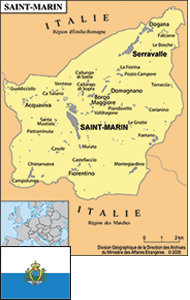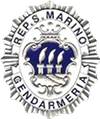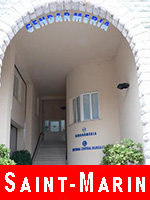 San Marino Gendarmerie Corps
San Marino Gendarmerie Corps
|
1842 Ministry of attachment: State Secretariat to Foreign Affairs Workforce: 85 General manager: Colonel Maurizio FARAONE Address: Viale J.F. Kennedy, 11 Tél. : (+378) 0549 882656 Fax : (+378) 0549 888057 Courriel : comando.gendarmeria@pa.sm 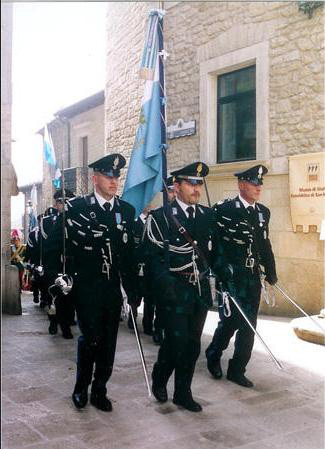
|
History
The Gendarmerie Corps was established on August 28th, 1842 in order to keep under control the public order within a particularly delicate and tempestuous historical period.
The Gendarmerie was initially provided with a staff composed of six gendarmes to whom only was attributed a steel-grey uniform with dark-red bands, different from the other Republic military corps uniform. The new military Corps was positioned for employment near the Captain of Regents - "Capitaine des Régents") - (Head of State).
Tasks of surveillance and supervision were also assigned to this Corps for the correct execution of the law and for investigations connected to any kind of crime or offence committed on the Republic territory. As the small State of San Marino didn’t have the means to create an organized permanent structure and capable in meeting the security needs mentioned above, the Gendarmerie Corps personnel was completed by recruiting servicemen in the "Grand Duchée" of Tuscany. During the interbellum period, as far as public order is concerned, the Italian Republic Guard helped the Gendarmerie Corps.
From 1962 till April 1984, the Gendarmerie Corps was strengthened with new officers coming from Italian Carabinieri Corps, with a staff of thirty persons. But until 1982, it was forbidden to the San Marino citizens to enlist in the Gendarmerie Corps. It is only in 1983, thanks to the modification of the regulations, that San Marino citizens (Or foreign citizens living in the Republic for at least 10 years) were authorized to join the Gendarmerie Corps.
Only the Corps Commander remains, still today, an Italian citizen, who, since 2015, is Colonel Maurizio FARAONE.
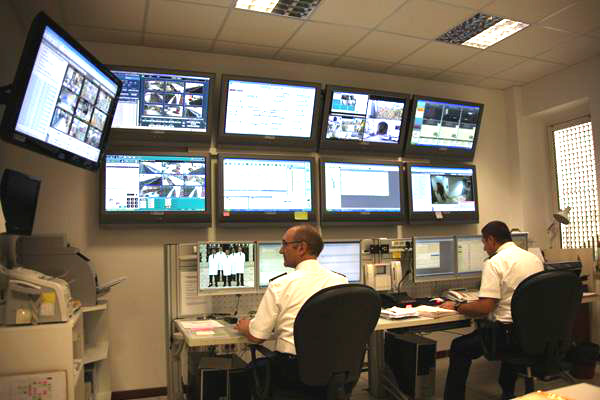
Organization
The Gendarmerie Corps is under the command of an officer having colonel’s rank to whom all the operational and administrative units of the Corps are referring to. It is organized in several services:
• The Central Command, run by a Marshal who oversees and supervises the Gendarmerie administration-logistic-accounting management and assures the Commander’s secretary, the administrative cooperation with the national and foreign authorities, the delivery of certified documents signed by the Commander. Furthermore, he oversees the escort and the protection service while coordinating the activities made by the nine (9) brigades police officers distributed in each of the nine (9) Castles into which the Republic of the San Marino is administratively divided.
• The Services of Prevention and the Patrol Unit, under the command of a Marshal, who is in charge of the territory control with patrols in service 24 hours a day and who also coordinates "the Operational Headquarters", "the Anti-Drug Unit" as well as the IT Office.
• The Criminal Investigation Department Service and intelligence unit which, under the command of a Marshal, performs criminal investigations activities as well as forensic and intelligence missions (This activity is also realized for the benefit of other Police Corps of San Marino.
• The Weapons Office, the Foreign Affairs Office, the Crime against women and children Office, the Data and Statistic Office. These offices, under the supervision of a Marshal, are responsible for all the criminal investigation and administrative police activities in these various domains (including, in a specific way, the ownership and the business of weapons, ammunitions, explosives and fireworks, as well as the immigration and the foreigners residence).
The Gendarmerie possesses also two specialized works groups, called the S.I.R. and C.Q.B., which are employed during major events or during law and order or public order incidents. Finally, the Gendarmerie is always responsible for the national prison.
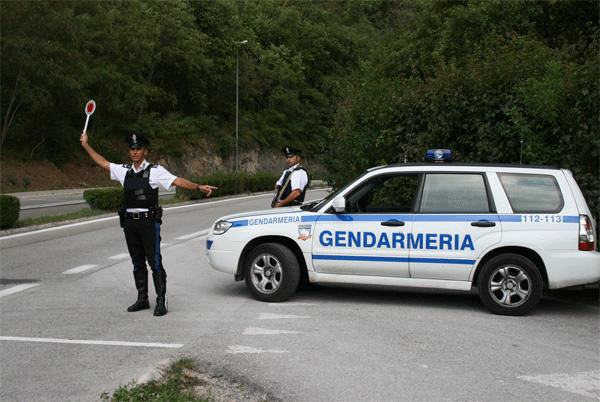
Missions
The Gendarmerie Corps is a police force with a military status, established in order to prevent and fight against the crime, to maintain the law and order and to guarantee the citizens security, the safety and the protection of their properties. This mission is conferred to the Gendarmerie Corps with the responsibility for assuring it in accordance with the laws, the decrees and the State regulations; and also in order to supply any help in case of disasters and to implement the public authorities legal decisions.
The Gendarmerie Corps also provides police escorts and security services to the Court and also to the judicial authority for the Criminal Investigation Department necessities.
The Gendarmerie Corps is responsible of the national prison.
The Gendarmerie Corps depends on:
• The "Regent Captains" ("Capitaines Régents") (State officials) for the law and public order, and for security;
• The State Secretariat to Foreign Affairs (Minister) for the recruitment, the administration, the equipment, the weapons and generally for all that is concerning the appropriate functioning of the service;
• The Magistracy for the duties in Criminal Investigation Department;
• The Military Congress for the military discipline.
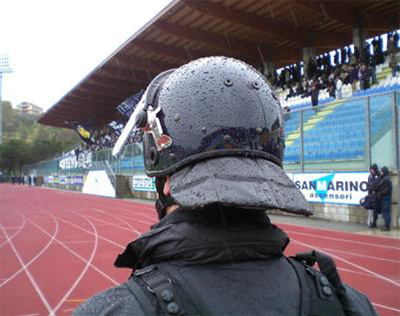
Staff
Besides the Commander, an officer with colonel rank, the Gendarmerie Corps counts presently eighty-five (85) military staffs with the ranks of:
• Marshal;
• Sergeant;
• Deputy sergeant;
• Officer;
• Gendarme;
• Junior Gendarme or "Gendarmerie Cadet".
The officers recruitment takes place at the request of the upper General Council (The Parliament) on proposal by the Foreign Affaires Secretary of State.
The recruitment in the Gendarmerie Corps with the junior gendarme (or "Gendarmerie cadet") rank takes place after a competition.
The promotion to the rank of deputy sergeant takes place according to the service duration; and between sergeant and Marshal through a competition.
The training of the junior gendarmes (or "Gendarmerie cadets") is carried out in the territory by the Gendarmerie.
In cooperation with the Italian Law and Order Department, according to the Agreements signed between both countries, specialized training sessions are carried out within the Police Academy in Italy.
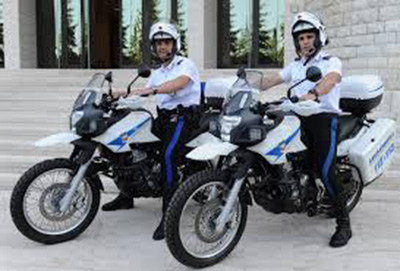
Main equipment
• Armament: Handguns: Glock 17, Beretta 92FS, Beretta 92SB, - Long gun: Rifle Beretta BM 59 calibre (FAL) 7,62 NATO – Collective weapons: submachine gun Winchester M1 calibre 30 – Beretta machine gun PM12, Heckler & Koch MP5 calibre 9 parabellum – Hunting gun Franchi SPAS 15 calibre 12, Assault rifle Beretta SC 70/90 calibre 5.56 NATO and Swiss grenade launcher GL 5040.
• Vehicles: Subaru Forestier – Motorcycle Aprilia Enduro – Gyropodes Segway – Mountain bike.
• Uniforms: Winter: Black pants with light blue stripe, light white shirt with tie, black jacket with blue profiles on the collar and on the shoulder straps; silver accessories and rank on shoulders – Summer: Black pants with light blue stripe, light white short-sleeved shirt with blue profiles; silver accessories and rank on shoulders – maintenance of law and order: Atlantic uniform of blue colour.
Cooperation
In the San Marino Republic, the police international cooperation is placed under the responsibility of the National Central Office – INTERPOL which, according to the law, is not part of the Police Corps, but acts under the direct authority of the Foreign Affaire Secretary of State and the State Secretary in charge of Internal Affairs and the Justice.
The San Marino Republic is completely surrounded by the Italian territory. That is the reason why a connection, placed under the San Marino and Rome NCBS-INTERPOL responsibility, was created thanks to the Agreements signed between San Marino and Italy. This connection is active between the San Marino Gendarmerie Operational Headquarter and the Police Headquarter in Rimini (Italy). It allows to both polices mutual exchanges of information and intelligence for a more effective control of the territories.
© The iconography was provided by the concerned gendarmeries

